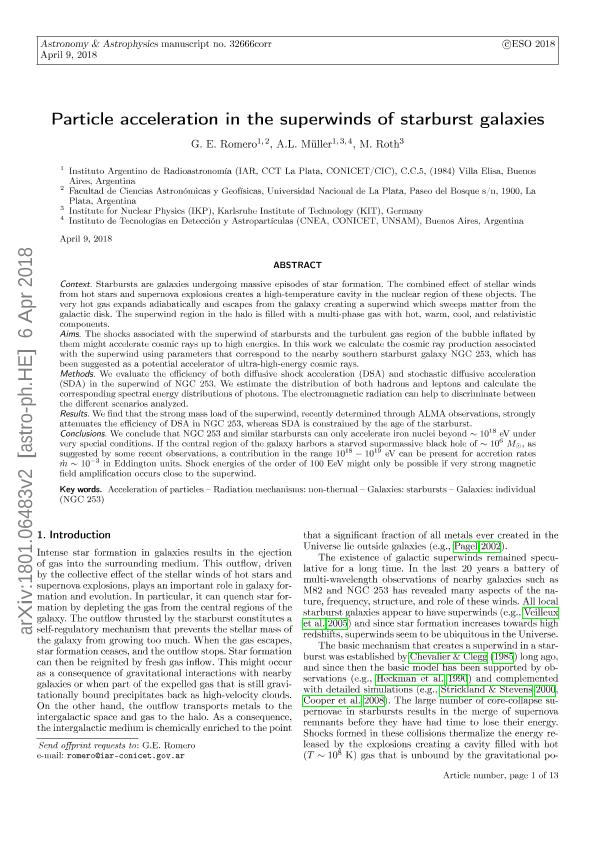Artículo
Particle acceleration in the superwinds of starburst galaxies
Fecha de publicación:
08/2018
Editorial:
EDP Sciences
Revista:
Astronomy and Astrophysics
ISSN:
0004-6361
Idioma:
Inglés
Tipo de recurso:
Artículo publicado
Clasificación temática:
Resumen
Context. Starbursts are galaxies undergoing massive episodes of star formation. The combined effect of stellar winds from hot stars and supernova explosions creates a high-temperature cavity in the nuclear region of these objects. The very hot gas expands adiabatically and escapes from the galaxy creating a superwind which sweeps matter from the galactic disk. The superwind region in the halo is filled with a multi-phase gas with hot, warm, cool, and relativistic components. Aims. The shocks associated with the superwind of starbursts and the turbulent gas region of the bubble inflated by them might accelerate cosmic rays up to high energies. In this work we calculate the cosmic ray production associated with the superwind using parameters that correspond to the nearby southern starburst galaxy NGC 253, which has been suggested as a potential accelerator of ultra-high-energy cosmic rays. Methods. We evaluate the efficiency of both diffusive shock acceleration (DSA) and stochastic diffusive acceleration (SDA) in the superwind of NGC 253. We estimate the distribution of both hadrons and leptons and calculate the corresponding spectral energy distributions of photons. The electromagnetic radiation can help to discriminate between the different scenarios analyzed. Results. We find that the strong mass load of the superwind, recently determined through ALMA observations, strongly attenuates the efficiency of DSA in NGC 253, whereas SDA is constrained by the age of the starburst. Conclusions. We conclude that NGC 253 and similar starbursts can only accelerate iron nuclei beyond ∼1018 eV under very special conditions. If the central region of the galaxy harbors a starved supermassive black hole of ∼106 M∗, as suggested by some recent observations, a contribution in the range 1018-1019 eV can be present for accretion rates ∼ 10-3 in Eddington units. Shock energies of the order of 100 EeV might only be possible if very strong magnetic field amplification occurs close to the superwind.
Archivos asociados
Licencia
Identificadores
Colecciones
Articulos(IAR)
Articulos de INST.ARG.DE RADIOASTRONOMIA (I)
Articulos de INST.ARG.DE RADIOASTRONOMIA (I)
Citación
Romero, Gustavo Esteban; Müller, A. L.; Roth, M.; Particle acceleration in the superwinds of starburst galaxies; EDP Sciences; Astronomy and Astrophysics; 616; A57; 8-2018; 1-14
Compartir
Altmétricas




